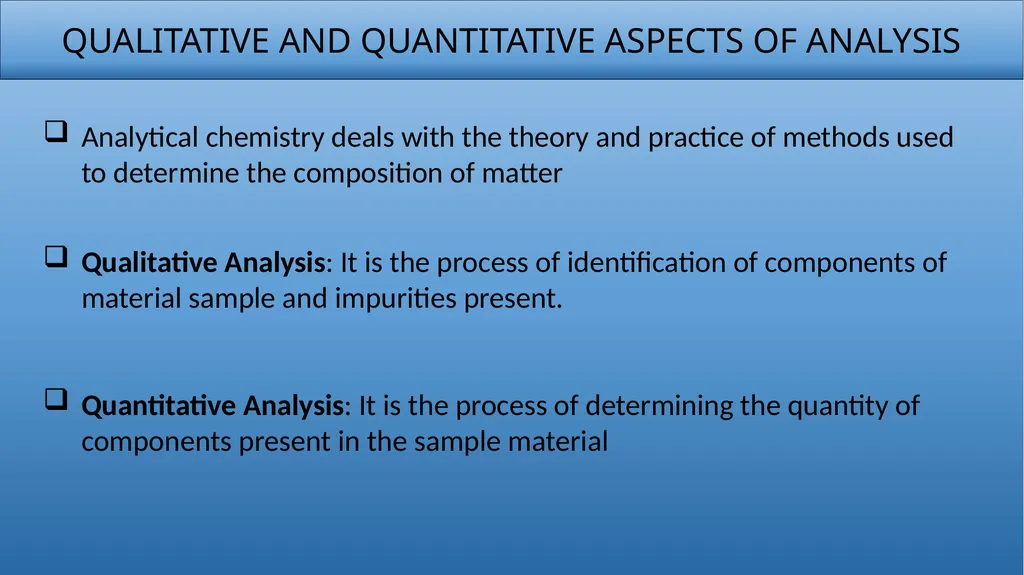QUALITATIVE AND QUANTITATIVE ASPECTS OF ANALYSIS
Author : calandra-battersby | Published Date : 2025-05-16
Description: QUALITATIVE AND QUANTITATIVE ASPECTS OF ANALYSIS Qualitative Analysis It is the process of identification of components of material sample and impurities present Quantitative Analysis It is the process of determining the quantity of
Presentation Embed Code
Download Presentation
Download
Presentation The PPT/PDF document
"QUALITATIVE AND QUANTITATIVE ASPECTS OF ANALYSIS" is the property of its rightful owner.
Permission is granted to download and print the materials on this website for personal, non-commercial use only,
and to display it on your personal computer provided you do not modify the materials and that you retain all
copyright notices contained in the materials. By downloading content from our website, you accept the terms of
this agreement.
Transcript:QUALITATIVE AND QUANTITATIVE ASPECTS OF ANALYSIS:
QUALITATIVE AND QUANTITATIVE ASPECTS OF ANALYSIS Qualitative Analysis: It is the process of identification of components of material sample and impurities present. Quantitative Analysis: It is the process of determining the quantity of components present in the sample material Analytical chemistry deals with the theory and practice of methods used to determine the composition of matter QUALITATIVE AND QUANTITATIVE ASPECTS OF ANALYSIS The analytical method involves using reason in a formal way to resolve problems. An analytical technique takes a problem, breaks it down into its constituent elements so that the problem may be understood, and then adds pieces that represent a solution. An analytical approach is required when dealing with complicated circumstances because they become too complex to resolve naturally. Every element must be formally recorded in writing, ERROR: A mistake is an action that you took that is considered incorrect, erroneous, or inappropriate. The word "error," which refers to a deviation from truth, accuracy, correctness, right, etc., is the most general in this comparison. Absolute Error: Relative Error: ACCURACY: Accuracy is generally the more significant characteristic of any quantitative analytical data that indicates the close proximity of the measurement to the true or expected value. Higher accuracy of any measurement is associated with minimization of error. Accuracy is a measure of how closely the result of an experiment agrees with the expected result. PRECISION: A substance's accuracy can be defined as the degree of agreement between two or more measurements. Precision and accuracy have no connection. You can be exact without being accurate. EXPRESSION OF RELIABILITY OF DATA There are a few terms or terminologies with the analytical measurements to improve the reliability of the course of action. Replicate: It refer to the sample of about the same size, which are investigated through an analytical procedure in exactly identical manner. For a set of replicate measurements, the mean or the median is used as a central value. MEAN: MEDIAN: The middle result obtained when replicate data are arranged in ascending or descending order. When the data set include an odd number of replicate measurements, the median is the middle value whereas for an even number of measurements, the median is the average of the N/2 and the (N/2)+1 measurements. Q. Calculate the mean and median values for the following set of measurements: 87.2, 87.8, 86.7, 88.1 and 87.3 Answer: Mean= 87.4, Median= 87.3 MEASURES OF SPREAD: It deals














